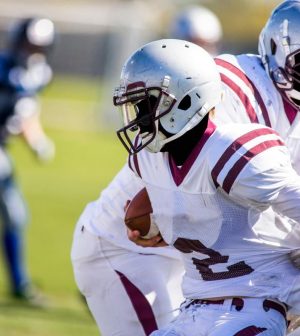- How Daily Prunes Can Influence Cholesterol and Inflammation
- When to Take B12 for Better Absorption and Energy
- Epsom Salts: Health Benefits and Uses
- See What Saffron Can Do for Sleep and Heart Health
- 6 Common Mistakes to Avoid Before Your Physical
- Can Sweating Really Help You Beat a Cold?
- Strengthening Your Relationship: Practical Strategies
- Skip Storing This Everyday Product in the Fridge Door
- Green Tea + B3 Pairing May Boost Brain Health
- Navigating Your Midlife Crisis: Embracing New Possibilities
One Part of Football Helmets Especially Linked to Concussion

Newfangled designs intended to make football helmets more protective have overlooked one key component, a new study suggests.
Nearly a third of concussions in pro football involve impacts to the facemask, a part of the helmet that has remained mostly unchanged during the past decade, researchers say.
Facemask enhancements could help protect players and minimize injury risk, the study concluded.
These findings “suggest that facemask redesign should be the focus of future innovation that can continue to improve the safety of football players at all skill levels,” said lead researcher Kristy Arbogast, scientific director of the Center for Injury Research and Prevention and co-director of the Minds Matter Concussion Program at the Children’s Hospital of Philadelphia.
For the study, researchers used mouthpieces fitted with motion sensors to track head impacts that NFL players sustained during games.
Nearly 100 players wore the mouthpieces during NFL seasons running from 2019 through 2022, and data was captured on more than 5,100 blows to the head that occurred during play.
Facemask impacts represented nearly 60% of the most severe head blows during play. Impacts to the facemask were most common among linemen (66%), followed by hybrid players (56%) and speed players (46%).
“The sophisticated and specific data collection from sensor technologies like instrumented mouthguards are providing a deeper understanding about the nature of impacts players experience on the field,” said Dr. Allen Sills, the NFL’s chief medical officer.
“This information is helping us to develop more effective interventions to reduce the frequency and severity head impacts and keep players healthy,” Sills added in a hospital news release.
There has been a 23% reduction in concussions among NFL players between the 2015-2017 seasons and the 2018-2019 season, researchers noted. This is due to better equipment, improved play techniques, new rules and better education regarding concussions.
“This study underscores the importance of using data and ongoing research efforts to continually self-assess and innovate as our research identifies new approaches that may help make the game safer not just for our professional athletes but ultimately for how the game is played at all levels,” said Dr. Thom Mayer, medical director of the NFL Players Association.
The findings were presented Sept. 11 at the International Research Council on Biomechanics of Injury conference, which took place in Stockholm, Sweden. Findings presented at medical meetings should be considered preliminary until published in a peer-reviewed journal.
More information
The U.S. Centers for Disease Control and Prevention has more on sports-related concussions.
SOURCE: Children’s Hospital of Philadelphia, news release, Sept. 11, 2024
Source: HealthDay
Copyright © 2026 HealthDay. All rights reserved.










